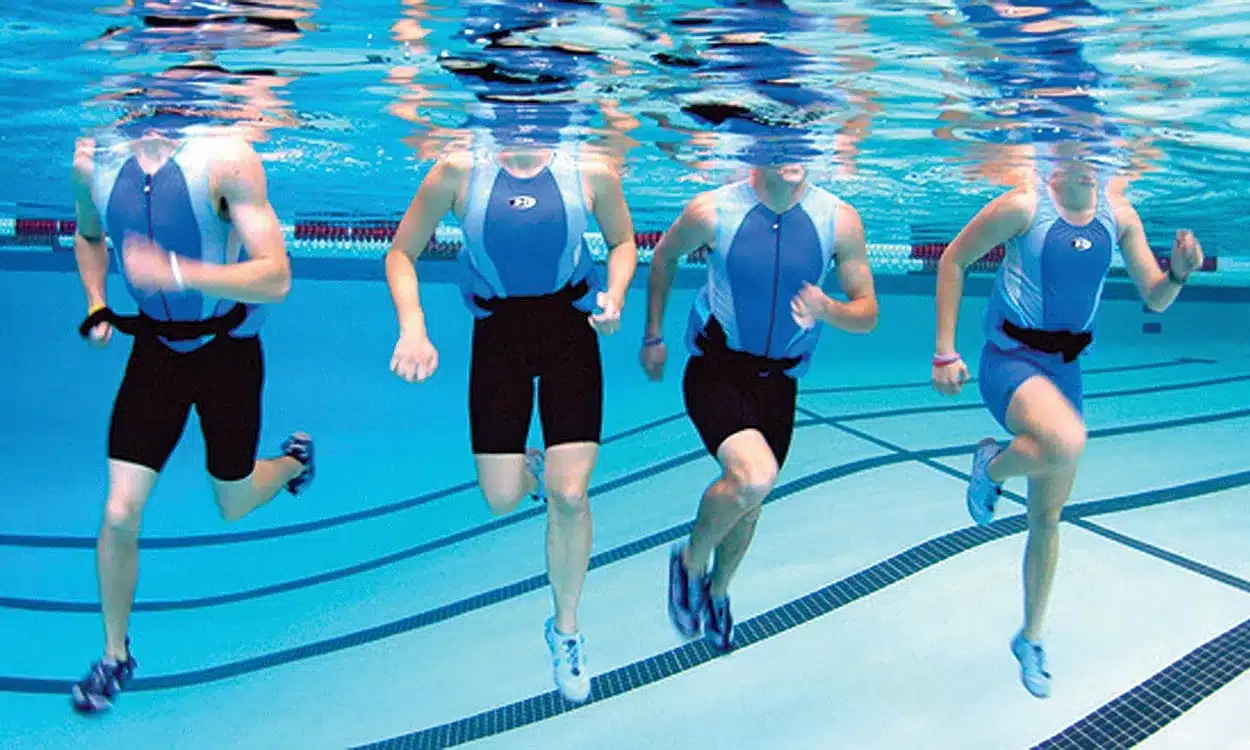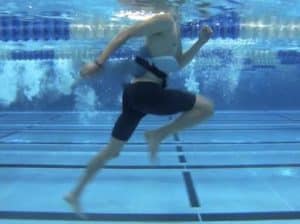Aqua Jogging for Runners: Rehab, Recovery, Strength

Getting injured sucks. It doesn’t matter if you’re an elite runner logging 120 miles per week or you are training for your first 5k; being sidelined is physically and emotionally hard to deal with. Unfortunately, getting injured also very common. Studies estimate that eighty-two percent of runners will get injured at some point in their running career. So, it’s likely to happen to you, especially if you exhibit training or structural issues that make you more likely to get injured. Since experts suggest that the majority of you reading this article are likely to get injured, I think it’s time I looked at the research and science concerning the benefits of one of the most effective cross training methods for runners, aqua jogging. More importantly, I am going to share some heart-pounding and gut-wrenching workouts that will help keep you fit should you be sidelined with an injury. This was something that I have learned over the year, and might well have save my year potentially had I got on board with it more after my injuries.
What is aqua jogging
Aqua jogging is a form of deep water running that closely mimics the actual running movement. Your feet don’t actually touch the bottom of the pool, so it is zero impact and safe for almost any type of injury. The only time to avoid aqua jogging is when you have a hip flexor injury, which can be aggravated by the increased resistance of the water as you bring your leg up. Because aqua jogging should closely mimic natural running form, it provides a neuromuscular workout that, in addition to aerobic benefits, helps keep the running specific muscles active. The same can’t be said for biking and swimming.
The downside to aqua jogging is that you need a pool that is deep enough to run in without touching the bottom. If you’re lucky enough to have access to a pool of this size, aqua jogging should be your first cross training choice.

How to aqua jog
Good aqua jogging form should imitate your running style fairly closely. You’ll want to submerse yourself in the deep end of the pool and use an aqua jogging belt if you’re a beginner or not a good swimmer. The belt is a nice tool, but once you get the form down, it isn’t necessary.
The key to good aqua jogging form is to keep your upper body straight and to not lean forward too much, which is a little different than your normal running posture. You should practice using a higher knee lift and a more compact back kick compared to running on dry land. This will allow you to remain upright and also enable you to perform harder sprinting activities. Here is a more thorough explanation (and an image) from the aquajogger website.
The benefits of aqua jogging
Studies have shown that aqua jogging can enable a well-trained runner to maintain running fitness for up to 4-6 weeks. In one study, a group of ten runners trained exclusively with deep water running for four weeks and compared 5km race times pre deep water running and post deep water running. The researchers found no statistical difference in 5k time or other markers for performance, such as submaximal oxygen consumption or lactate threshold.
In a second study, researchers measured the effects of aqua jogging over a six week period. This time, 16 runners were separated into two groups – one who did aqua jogging workouts and the other who did over land running. Using the same training intensities and durations, the researchers found no difference between the groups in maximal blood glucose, blood lactate, and body composition.Finally, research has also demonstrated that aqua jogging can be used as a recovery tool to facilitate the repair of damaged muscles after hard workouts. These findings make aqua jogging an important recovery tool in addition to be an optimal cross training method.
Sample aqua jogging workouts
Before we get started with specific workouts, it’s important to realize that elevating your heart rate in the pool will be more difficult than on dry land. Since your cells are 65-95% water, blood circulates better when submerged, which means your heart does not need to pump as hard to circulate oxygen. So, the benefits from pool running must come from a constant, steady effort or intervals.
Definition of terms
Rest = No jogging, just rest in the water
Easy = 65-75% of maximum heart rate. Basically a typical easy/recovery run effort
Medium = 87-92% of maximum heart rate. What you would consider a hard tempo run effort; comfortably hard.
Hard = 95-100% of maximum heart rate. All out sprints.
Easy pool running
Easy pool running should only be used as warm-up for harder aqua jogging workouts, a recovery tool between hard workouts, or to simulate longer training runs. You can perform easy pool running just like you would perform easy running on dry land, there is nothing fancy about it. You should try to maintain a heart rate that is 65-75% of your maximum heart rate, at a pace/effort you can hold a conversation at.
Medium effort aqua jogging workouts
1. 10 min easy w/u, 1:00 hard, 30 sec easy, 1:30 hard, 30 sec easy, 2:00 hard, 30 sec easy (continue building up until 5:00, and then come back down by 30 second intervals) 10 min easy c/d
2. 10 min easy w/u, 1min medium, 1 min sprint, 30 sec hands in air (keep moving your legs in the running motion, but put your hand above your head), 1 min rest – repeat 10-15 times. 10 min easy c/d
3. 10 min easy w/u, 30sec sprint, 30sec medium, 30sec sprint, 30sec medium – 30 rest, Repeat 12-15 times, 10 min easy c/d
4. 10 min easy w/u, 10 sec medium, 10 second sprint, 10 second easy, 20 sec medium, 20 sec sprint, 20 sec easy, 30 sec medium, 30 sec sprint, 30 sec easy, repeat up to 70 seconds and the back down, 10 min easy c/d
Hard aqua jogging workouts
One of the difficulties of cross training is replicating those truly lung-busting, difficult workouts. With the pool, I’ve actually read about a very nice trick to help make pool running as hard as any track workout you might do. If you’re going to be pool running quite a bit due to injury or limited training volume, invest in a bungee cord designed for sprinters. Tie one end of the resistance band to a sturdy object (pole, lifeguard stand, pool ladder) and bring the other into the water with you. Put the strap around your waist and begin aqua jog away from your starting point. You’ll begin to notice the bungee tighten and resist against you (depending on the length of your pool, you may need to wrap the bungee around the supporting object or tie it in knots to make it shorter to feel resistance). Spend a few moments testing yourself to see how far you can pull the bungee. This is a great challenge and a fun way to compete with yourself during an otherwise boring cross training activity. Finally, pick a point on the pool wall or side of the pool that you feel stretches the bungee to a very hard sprint that you could maintain for 60-90 seconds. This will be your “sprint” marker that you’ll use on sprint intervals. Likewise, find a point that feels like the end of a hard tempo run. Mark this spot as your “medium” interval distance. Now, when you complete the hard workouts, you can use these reference points to ensure that you maintain a very hard effort.
1. 10 min easy w/u, 90 sec easy (slowly moving out and stretching the bungee), 2 min medium, 1 min sprint, 1 min rest (let the bungee pull you back – this is fun) x 10, 10 min easy c/d
2. 10 min easy w/u, 90 sec easy, 5 min medium (focus and concentrate, just like during the hard part of a race), 30 sec sprint, 2 min rest, x 4, 10 min easy c/d
3. 10 min easy w/u, 90 sec easy, 2 min sprint, 90 sec rest x 12, 10 min easy c/d
You can challenge yourself and make aqua jogging more fun by seeing how long you can stay at your maximum stretched distance or seeing how far you can push it. Likewise, if you have a friend who is injured (or someone willing to be a good sport) you can try pulling each other across the pool for some competitive fun.
Cross training can be tough, especially when you’re injured or want to be increasing your volume faster. However, I hope that providing a variety of workouts, a fun challenge in the pool, and a little science about the benefits of aqua jogging will help you emerge from your injury with minimal fitness loss.
Send us a message or leave a comment and let us know if you have any questions! We all have our own thoughts on the matter, and we all have something different that suits us.
See what’s up next week for our #RunFormFriday tip! For more in depth understanding on how to put this into practise, get in touch and we’ll see how we can help!
